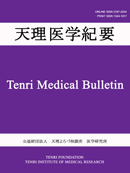Volume 23, Issue 2
Displaying 1-9 of 9 articles from this issue
- |<
- <
- 1
- >
- >|
Original Article
-
Article type: Original Article
2020 Volume 23 Issue 2 Pages 58-73
Published: December 25, 2020
Released on J-STAGE: December 25, 2020
Download PDF (9364K) -
Article type: Original Article
2020 Volume 23 Issue 2 Pages 74-78
Published: December 25, 2020
Released on J-STAGE: December 25, 2020
Download PDF (779K) -
Article type: Original Article
2020 Volume 23 Issue 2 Pages 79-85
Published: December 25, 2020
Released on J-STAGE: December 25, 2020
Download PDF (682K)
2019 Symposium of the Tenri Institute of Medical Research
-
Article type: 2019 Symposium of the Tenri Institute of Medical Research
2020 Volume 23 Issue 2 Pages 88-95
Published: December 25, 2020
Released on J-STAGE: December 25, 2020
Download PDF (2989K) -
Article type: 2019 Symposium of the Tenri Institute of Medical Research
2020 Volume 23 Issue 2 Pages 96
Published: December 25, 2020
Released on J-STAGE: December 25, 2020
Download PDF (265K) -
Article type: 2019 Symposium of the Tenri Institute of Medical Research
2020 Volume 23 Issue 2 Pages 97-103
Published: December 25, 2020
Released on J-STAGE: December 25, 2020
Download PDF (2572K) -
Article type: 2019 Symposium of the Tenri Institute of Medical Research
2020 Volume 23 Issue 2 Pages 104-112
Published: December 25, 2020
Released on J-STAGE: December 25, 2020
Download PDF (2016K) -
Article type: 2019 Symposium of the Tenri Institute of Medical Research
2020 Volume 23 Issue 2 Pages 113-119
Published: December 25, 2020
Released on J-STAGE: December 25, 2020
Download PDF (707K)
Pictures at Bedside and Bench
-
Article type: Pictures at Bedside and Bench
2020 Volume 23 Issue 2 Pages 120-124
Published: December 25, 2020
Released on J-STAGE: December 25, 2020
Download PDF (3525K)
- |<
- <
- 1
- >
- >|
